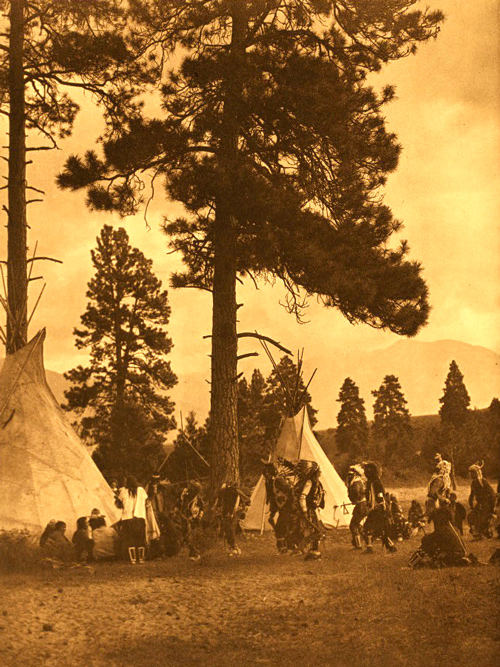At present Ross’ Hole, Montana, a council with the Flathead Salish is held using five different languages: Salish-Shoshone–Hidatsa–French–English. Gifts are exchanged, and then horse-trading commences.
The Mythical Welch Indians[1]Originally aired weekdays by Yellowstone Public Radio during the Bicentennial observance of 2003-2006. Narrated by Hal Hansen. Scripts by Whit Hansen and Ed Jacobson. Produced by Leni Holliman. © … Continue reading
by Yellowstone Public Radio[2]Originally aired weekdays by Yellowstone Public Radio during the Bicentennial observance of 2003-2006. Narrated by Hal Hansen. Scripts by Whit Hansen and Ed Jacobson. Produced by Leni Holliman. © … Continue reading
Flathead Camp
Edward S. Curtis (1868–1952)
Courtesy Northwestern University Library, Edward S. Curtis’s ‘The North American Indian’: the Photographic Images.
The “Eoote-lash-Schute”
They Call themselves Eoote-lash-Schute [Salish] and consist of 450 Lodges in all and divided into Several bands on the heads of the Columbia river & Missouri, Some low down the Columbia River
—William Clark
Flathead Salish Council
we assembled the Chiefs & warriers and Spoke to them (with much dificuely as what we Said had to pass through Several languajes before it got in to theirs, which is a gugling kind of languaje Spoken much thro the Throught) we informed them who we were, where we Came from, where bound and for what purpose &c. &c.
—William Clark
The translation went from Salish (a Shoshone boy) to Shoshone (Sacagawea) to Hidatsa (Charbonneau) to French to English.
Exchanging Gifts
we made 4 Chiefs whome we gave meadels & a few Small articles with Tobacco; the women brought us a few berries & roots to eate and the Principal Chief a Dressed Brarow [Badgers], otter & two Goat & antilope [pronghorn] Skins
—William Clark
Trading for Horses
in the Course of the day I purchased 11 horses & exchanged 7 for which we gave a fiew articles of merchendize. those people possess ellegant horses.—
—William Clark
Ross’ Hole near Sula, Montana
© 5 September 2013 by Kristopher K. Townsend. Permission to use granted under the Creative Commons Attribution-Share Alike 4.0 International license.
Weather Diary
State of the Thermometer at rise
Weather at rise
Wind at rise
State of the Thermometer at 4 P.M. Weather at 4 P.M. Wind at 4 P.M. 17 [above 0] cloudy after snow N E. 29 [above 0] cloudy after rain & snow N E Ground Covered with Snow.
—Meriwether Lewis[3]To assist the reader, the editor of this web page has omitted the date column and spelled out some abbreviations.
Ross Hole is a High Potential Historic Site along the Lewis and Clark National Historic Trail managed by the U.S. National Park Service. On US Highway 93, at the Sula Country Store, a road-side pull-off provides views of the valley and interpretive signs.
Notes
| ↑1 | Originally aired weekdays by Yellowstone Public Radio during the Bicentennial observance of 2003-2006. Narrated by Hal Hansen. Scripts by Whit Hansen and Ed Jacobson. Produced by Leni Holliman. © 2003 by Yellowstone Public Radio. |
|---|---|
| ↑2 | Originally aired weekdays by Yellowstone Public Radio during the Bicentennial observance of 2003-2006. Narrated by Hal Hansen. Scripts by Whit Hansen and Ed Jacobson. Produced by Leni Holliman. © 2003 by Yellowstone Public Radio. |
| ↑3 | To assist the reader, the editor of this web page has omitted the date column and spelled out some abbreviations. |
Experience the Lewis and Clark Trail
The Lewis and Clark Trail Experience—our sister site at lewisandclark.travel—connects the world to people and places on the Lewis and Clark Trail.
Discover More
- The Lewis and Clark Expedition: Day by Day by Gary E. Moulton (University of Nebraska Press, 2018). The story in prose, 14 May 1804–23 September 1806.
- The Lewis and Clark Journals: An American Epic of Discovery (abridged) by Gary E. Moulton (University of Nebraska Press, 2003). Selected journal excerpts, 14 May 1804–23 September 1806.
- The Lewis and Clark Journals. by Gary E. Moulton (University of Nebraska Press, 1983–2001). The complete story in 13 volumes.





